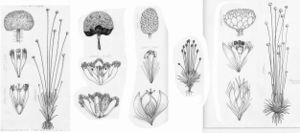Lachnocaulon engleri
in H. G. A. Engler,Das Pflanzenreich 13[IV,30]: 241. 1903.
Herbs, short-lived perennial, solitary or cespitose, forming low domes of rosettes, 6–15 cm. Leaves mostly linear-triangular, 2–4 cm, apex acute. Inflorescences: scape sheaths shorter than or as long as principal leaves; scapes filiform, distally 0.4 mm thick, 4–5-ribbed, glabrous; mature heads dark-brown or reddish-brown, nearly globose, usually short cylindric by seeding time, 3–4 mm; receptacle densely pilose; involucral-bracts soon reflexed, brown, mostly ovate, 1 (–1.5) mm, apex broadly acute to obtuse, surfaces glabrous or apex sparsely pilose, hairs translucent, club-shaped; receptacular-bracts, dark-brown, broadly spatulate or obovate-cuneate, concave, with broad, low, pale keel, 1–1.5 mm, apex short-acuminate, glabrous or abaxial surface with translucent, club-shaped hairs distally. Staminate flowers: sepals 3, dark-brown, narrowly spatulate to oblanceolate-cuneate, concave, 1 mm, glabrous or abaxially with scattered translucent, club-shaped hairs distally; androphore pale, narrowly obconic, as long as sepals, glabrous, rarely apex with few club-shaped hairs; stamens 2–3, appendages (2–) 3. Pistillate flowers: sepals 3, dark-brown, spatulate-oblong, concave, 1 mm, abaxially sparsely pubescent distally, hairs translucent; gynoecium 3-carpellate; styles: apex 3-cleft, appendages 3. Seeds rich translucent brown, broadly ovoid to ellipsoid, 0.4–0.5 mm, longitudinal ribs conspicuous and pale, transverse striae fine forming linear cancellae.
Phenology: Flowering summer–fall.
Habitat: Moist sandy-peaty lake and pond shores, drawdowns, ditchbanks, low sandy clearings in savanna and flatwoods
Elevation: 0–100 m
Discussion
Of conservation concern.
Selected References
None.

